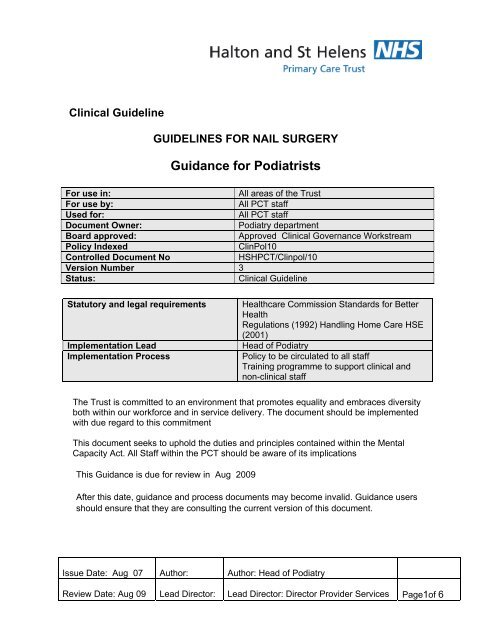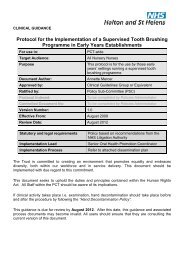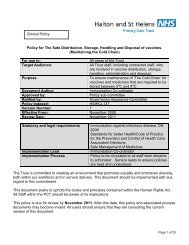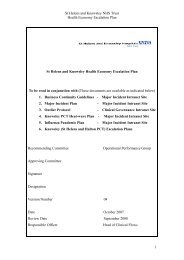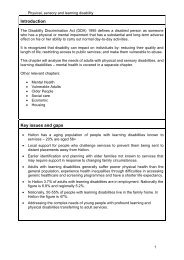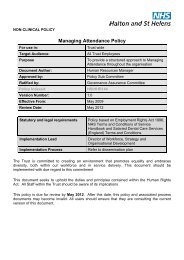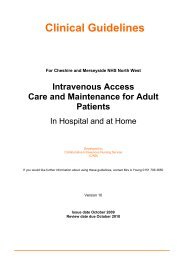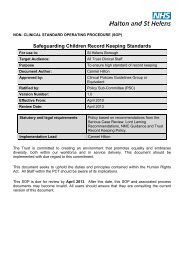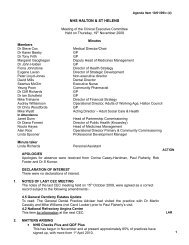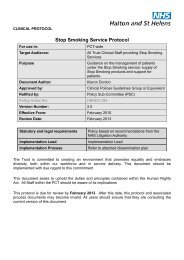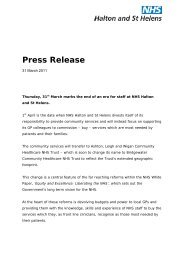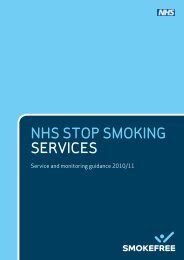Guidance For Podiatrists - Halton and St Helens PCT
Guidance For Podiatrists - Halton and St Helens PCT
Guidance For Podiatrists - Halton and St Helens PCT
Create successful ePaper yourself
Turn your PDF publications into a flip-book with our unique Google optimized e-Paper software.
Clinical Guideline<br />
GUIDELINES FOR NAIL SURGERY<br />
<strong>Guidance</strong> for <strong>Podiatrists</strong><br />
<strong>For</strong> use in:<br />
All areas of the Trust<br />
<strong>For</strong> use by:<br />
All <strong>PCT</strong> staff<br />
Used for:<br />
All <strong>PCT</strong> staff<br />
Document Owner:<br />
Podiatry department<br />
Board approved:<br />
Approved Clinical Governance Workstream<br />
Policy Indexed<br />
ClinPol10<br />
Controlled Document No<br />
HSH<strong>PCT</strong>/Clinpol/10<br />
Version Number 3<br />
<strong>St</strong>atus:<br />
Clinical Guideline<br />
<strong>St</strong>atutory <strong>and</strong> legal requirements<br />
Implementation Lead<br />
Implementation Process<br />
Healthcare Commission <strong>St</strong><strong>and</strong>ards for Better<br />
Health<br />
Regulations (1992) H<strong>and</strong>ling Home Care HSE<br />
(2001)<br />
Head of Podiatry<br />
Policy to be circulated to all staff<br />
Training programme to support clinical <strong>and</strong><br />
non-clinical staff<br />
The Trust is committed to an environment that promotes equality <strong>and</strong> embraces diversity<br />
both within our workforce <strong>and</strong> in service delivery. The document should be implemented<br />
with due regard to this commitment<br />
This document seeks to uphold the duties <strong>and</strong> principles contained within the Mental<br />
Capacity Act. All <strong>St</strong>aff within the <strong>PCT</strong> should be aware of its implications<br />
This <strong>Guidance</strong> is due for review in Aug 2009<br />
After this date, guidance <strong>and</strong> process documents may become invalid. <strong>Guidance</strong> users<br />
should ensure that they are consulting the current version of this document.<br />
Issue Date: Aug 07 Author: Author: Head of Podiatry<br />
Review Date: Aug 09 Lead Director: Lead Director: Director Provider Services Page1of 6
Contents<br />
Page No<br />
1 Rationale 3<br />
1.1 Related Trust Policies 3<br />
1.2 List of Equipment 3<br />
1.3 Risk Assessment <strong>and</strong> COSHH 4<br />
1.4 Training 4<br />
2 General principles – Procedure for Nail Surgery 5<br />
2.1 Referrals 5<br />
2.2 History <strong>and</strong> Pre-operative assessment 5<br />
2.3 Consent 6<br />
2.4 Preparation of Area 6<br />
2.5 Decontamination of Instruments 7<br />
2.6 Decontaminating H<strong>and</strong>s <strong>and</strong> Protective Clothing 7<br />
2.7 Procedure 8<br />
2.8 Dressings <strong>and</strong> Post op Information 9<br />
2.9 Operation Report 9<br />
3 Audit 10<br />
4 Management of Guidelines <strong>and</strong> 10<br />
5 References 10<br />
Appendices<br />
1. Rationale<br />
Issue Date: Aug 07 Author: Author: Head of Podiatry<br />
Review Date: Aug 09 Lead Director: Lead Director: Director Provider Services Page2 of 10
The condition of in-growing toenail (onychocryptosis) usually affects the hallux nail,<br />
<strong>and</strong> is most commonly seen between the ages of fifteen <strong>and</strong> forty years, with a male<br />
to female predominance of about 3:1 ( Davies C S 1993). Since the introduction of<br />
Local Anaesthesia (LA) into Podiatry practice in 1972, the principle management for<br />
onychocryptosis has been the ablation of the nail matrix using Liquefied Phenol B.P.<br />
either partially or total (McCourt F J. 1999).<br />
This guidance is intended to ensure that podiatry staff undertaking nail surgery<br />
employed by <strong>Halton</strong> <strong>and</strong> <strong>St</strong> Helen’s <strong>PCT</strong> do so safely for both patients <strong>and</strong><br />
themselves meeting the objectives listed in the policy statement.<br />
<strong>Halton</strong> <strong>and</strong> <strong>St</strong> <strong>Helens</strong> <strong>PCT</strong> podiatry department is committed in offering patients this<br />
specialist nail surgery in a community setting. The objective of nail surgery is to<br />
permanently resolve the condition of onychocryptosis by either total or partial nail<br />
avulsion with nail matrix ablation.<br />
1.1 Related trust Policies<br />
Record Keeping Policy (2006)<br />
Consent Policy (2007)<br />
Clinical Guidelines for use of Sc<strong>and</strong>onest 3% in Children plus LA for adults (2005)<br />
PGD for Adrenaline (2005)<br />
Latex Policy (2005)<br />
Infection Control Policy<br />
Policy on use of <strong>St</strong>erilizers<br />
1.2 List of Equipment<br />
Thwaites Nippers, Blacks file, McKay Nail elevator, Spencer-wells <strong>For</strong>ceps, Mosquito<br />
forceps, Locke elevator, No 3<br />
Scalpel h<strong>and</strong>le, small <strong>and</strong> large tube gauze applicators, scissors, beaver h<strong>and</strong>le, dental<br />
cartridge syringe tourniquets.<br />
Issue Date: Aug 07 Author: Author: Head of Podiatry<br />
Review Date: Aug 09 Lead Director: Lead Director: Director Provider Services Page3 of 10
1.3 Risk assessment <strong>and</strong> COSHH (1988)<br />
• The North West Regional Sub-group <strong>and</strong> infection control nurses support the use<br />
of a disposable pastette for applying the phenol to the sulcus. It is imperative that<br />
they are discarded in yellow bag.<br />
• <strong>For</strong> staff that use the dropper bottle, this is still acceptable as the risk of cross<br />
infection is very low.<br />
• A full risk assessment<br />
•<br />
1.4 Training<br />
• Newly qualified staff should not work alone with a podiatry assistant for a period<br />
of 12 months/20 procedures without being supervised by a senior podiatrist with<br />
sufficient nail surgery experience. During this period all types of nail surgery<br />
should be undertaken.<br />
• All clinicians performing N/S to undertake 10 nail op procedures each year.<br />
Retraining to be offered if this is not met.<br />
• All staff to undertake retraining each year in resuscitation, dealing with<br />
anaphylaxis <strong>and</strong> administration of adrenalin.<br />
Issue Date: Aug 07 Author: Author: Head of Podiatry<br />
Review Date: Aug 09 Lead Director: Lead Director: Director Provider Services Page4 of 10
General Principles<br />
PROCEDURE FOR NAIL SURGERY<br />
ACTION<br />
2.1 Referrals<br />
All referrals from trust podiatry staff can be<br />
booked into nail surgery clinics directly via the<br />
podiatry office at Victoria House.<br />
All referrals from other sources i.e. self/primary<br />
health care team should be provisionally<br />
assessed for suitability for nail surgery in the<br />
emergency clinics at HCRC or Hallwood. If nail<br />
surgery is required, the patients can be booked<br />
into nail surgery clinics via the podiatry office at<br />
Victoria House.<br />
2.2 History<br />
ACTION<br />
Basic pre-op information, including what happens<br />
during the procedure, re-growth rate (1% @ last<br />
audit), healing time, time off work/school, not to<br />
drive after the procedure, should be given<br />
verbally <strong>and</strong> in writing by means of a patient<br />
information leaflet<br />
Record name, address, Date of birth, telephone<br />
number, General Practitioner <strong>and</strong> presenting<br />
condition.<br />
Undertake primary assessment.<br />
Pulses – if absent test with Doppler – if still<br />
absent or weak monophasic, then nail surgery is<br />
not advisable.<br />
Undertake medical history including blood<br />
disorders, sickle cell, hepatitis, infection not<br />
responded to antibiotics, diabetes, neurological,<br />
heart disease, Raynaulds, Epilepsy, respiratory<br />
condition, pregnancy, kidney problems, allergies,<br />
arthritis, skin conditions, previous Local<br />
Anaesthetic.<br />
Current medication including over the counter,<br />
herbal steroids/anticoagulants in the last 6<br />
months. Smoker.<br />
Indicate what procedure is indicated.<br />
RATIONALE<br />
RATIONALE<br />
To ensure patient is properly informed.<br />
To comply with good record keeping<br />
practice.<br />
To ensure patient is suitable for surgery.<br />
To ensure patient is suitable for surgery<br />
Minimising any risk<br />
To inform patient<br />
Issue Date: Aug 07 Author: Author: Head of Podiatry<br />
Review Date: Aug 09 Lead Director: Lead Director: Director Provider Services Page5 of 10
2.3 Consent<br />
Full informed consent in writing should be<br />
obtained from the patient (parent or guardian if<br />
under 16) for the administration of the local<br />
anaesthetic <strong>and</strong> operative procedure.<br />
ACTION<br />
Consent should include what procedure is to be<br />
carried out, a statement which conveys that the<br />
procedure has been explained in terms that the<br />
operator judges the patient/parent or guardian<br />
have understood, a space for the operator to sign<br />
<strong>and</strong> date this statement, a statement that states<br />
the patient/parent or guardian has had the<br />
procedure explained <strong>and</strong> that they agree to it,<br />
<strong>and</strong> a space for the signature of the<br />
patient/parent or guardian.<br />
High-risk patients should not have nail surgery<br />
performed on a Friday, while the service runs<br />
Monday to Friday hours.<br />
High-risk patients should have their medical<br />
circumstances checked out via letter to their<br />
consultant/GP. Patients taking Warfarin, their<br />
INR’s should be around 2.<br />
Consultants/GPs should have notification of the<br />
problems that may occur from a high-risk patient<br />
having nail surgery – LA/phenol/tourniquet/post<br />
op bleeding/healing/immune problem.<br />
Adrenalin should be available during procedure.<br />
2.4 Preparation of Area<br />
ACTION<br />
The general area where nail surgery is carried out<br />
should be dust free, have good ventilation, <strong>and</strong><br />
have a minimal amount of people entering during<br />
a session.<br />
The room to be used is made ‘clean’, i.e. the<br />
chair, lamp, unit, <strong>and</strong> any other surfaces such as<br />
window ledges are swabbed thoroughly. A<br />
general-purpose detergent (Hospec) <strong>and</strong> hot<br />
water (5ml per 5 litres hot water) is adequate for<br />
general environmental cleaning.<br />
Prepare the trolley <strong>and</strong> patient chair with blue<br />
paper roll.<br />
To ensure that the patient/parent or<br />
guardian is aware of what the procedure<br />
involves, its risks, side effects of LA,<br />
outcome <strong>and</strong> average healing time.<br />
Patients/parents or guardian should be<br />
issued with a patient information sheet on<br />
nail surgery on their initial assessment<br />
appointment.<br />
RATIONALE<br />
To comply with Trust Consent Policy.<br />
As weekend cover not available.<br />
In order to ascertain their suitability for nail<br />
surgery.<br />
So that any necessary counter measures<br />
can be taken<br />
In case of emergency<br />
RATIONALE<br />
To minimise risk of infection.<br />
To minimise risk of infection.<br />
Issue Date: Aug 07 Author: Author: Head of Podiatry<br />
Review Date: Aug 09 Lead Director: Lead Director: Director Provider Services Page6 of 10
Between each patient the chair <strong>and</strong> unit should<br />
be cleaned with a detergent (Hospec) <strong>and</strong> hot<br />
water.<br />
Use one dedicated sink only for cleaning<br />
instruments.<br />
2.5 Decontamination of Instruments<br />
ACTION<br />
Instruments must be washed in hot water <strong>and</strong> a<br />
detergent (Hospec). A dedicated scrubbing brush<br />
can be used for scrubbing the instruments under<br />
the surface of the water. Instruments must not be<br />
scrubbed in running water or above the surface of<br />
water as this can create an aerosol.<br />
All instruments used should be autoclaved prior<br />
to use. Instruments must be placed on trays<br />
provided without overloading. Instruments must<br />
not touch each other. Hinged instruments must<br />
be opened out, while instruments with a lumen,<br />
i.e. beaver h<strong>and</strong>le should be fully undone.<br />
Remove sterile instruments on their tray to a<br />
clean area prior to use. Do not place by the sink<br />
as this area may be contaminated by the water<br />
used in cleaning the instruments <strong>and</strong> h<strong>and</strong><br />
washing.<br />
2.6 Decontaminating H<strong>and</strong>s <strong>and</strong> Protective<br />
Clothing – Decontamination of h<strong>and</strong>s is the<br />
single most important factor in preventing cross<br />
infection. Both operator <strong>and</strong> assistant should<br />
“scrub up” before <strong>and</strong> after procedure<br />
Decontaminate h<strong>and</strong>s in accordance with<br />
the <strong>PCT</strong> H<strong>and</strong> Decontamination Policy<br />
Use one of the sinks only for h<strong>and</strong>- washing.<br />
A disposable plastic apron should be worn.<br />
The operator should wear sterile surgical gloves<br />
during the nail surgery procedure, however the<br />
assistant’s gloves need not be sterile.<br />
Eye protection should be available to staff<br />
carrying out nail surgery.<br />
Surgical face masks do not protect staff from<br />
phenol fumes, but should be made available<br />
should staff wish to use them<br />
To prevent cross infection.<br />
To prevent contamination from other<br />
sources.<br />
RATIONALE<br />
May be a vector of cross infection to staff.<br />
To comply with Trust policy for use of<br />
sterilizers<br />
To minimise risk of infection.<br />
In order to reduce the risk of cross<br />
infection.<br />
To prevent h<strong>and</strong> contamination from used<br />
instruments.<br />
To protect clothing.<br />
To ensure sterile procedure.<br />
To protect eyes.<br />
In order to reduce the risk of cross infection.<br />
Issue Date: Aug 07 Author: Author: Head of Podiatry<br />
Review Date: Aug 09 Lead Director: Lead Director: Director Provider Services Page7 of 10
2.7 Procedure in case of emergency.<br />
Adrenalin should be to h<strong>and</strong> before LA is<br />
administered.<br />
Explain to the patient that an injection is given to<br />
both sides of the toe.<br />
Check the name, form, strength, batch No, <strong>and</strong><br />
expiry date of the LA. Check the needle seal has<br />
not been broken.<br />
The patient should be reclined for the LA <strong>and</strong><br />
procedure, unless medically unfit (i.e. angina).<br />
Administer the LA warning the patient when the<br />
needle is to be inserted, <strong>and</strong> that they need to<br />
keep still. Non-sterile gloves should be worn for<br />
this procedure.<br />
Aspirate to check the needle has not been<br />
inserted into a blood vessel if continuous<br />
administration has not been used. Keep fingers<br />
clear of the posterior aspect of the toe – use skin<br />
blanch as a guide.<br />
At the end of the procedure remove the needle<br />
<strong>and</strong> discard into sharps bin along with the used<br />
cartridge.<br />
Allow sufficient time for the toe to become<br />
anaesthetized. Test this by using a probe/neuro<br />
tip over the area to be treated. If achieved,<br />
discard gloves, put on apron, <strong>and</strong> protective<br />
eyewear, if using.<br />
Decontaminate h<strong>and</strong>s, dry on clean paper towels<br />
<strong>and</strong> put on sterile surgical gloves.<br />
The forefoot should be swabbed with a pre-op<br />
alcohol based solution working distally to<br />
proximally.<br />
De-vascularise the toe using a tourniquet. The<br />
assistant should time how long this is applied,<br />
which should not exceed 15 minutes.<br />
Carry out the Partial Nail Avulsion/Total Nail<br />
Avulsion, <strong>and</strong> check for completeness.<br />
The assistant applies phenol to the area of matrix<br />
to be cauterised, using the smallest amount in a<br />
pastette.<br />
The phenol should be applied for a total of 3<br />
minutes using a blacks file. The area should then<br />
be dried with sterile gauze.<br />
Phenol is washed out with Isopropyl Alcohol.<br />
Tourniquet is removed <strong>and</strong> the toe checked for<br />
re-vascularisation <strong>and</strong> bleeding. The total time of<br />
de-vascularisation is noted.<br />
To anaesthetize the whole toe.<br />
To ensure correct drug has been selected,<br />
<strong>and</strong> not been tampered with, <strong>and</strong> to ensure<br />
expiry date has not been exceeded.<br />
To ensure patient comfort.<br />
To ensure patient comfort <strong>and</strong> to prevent a<br />
needle stick injury to staff.<br />
To prevent local anaesthetic being<br />
administered into a blood vessel<br />
intravenously. To prevent needle stick<br />
injury.<br />
<strong>For</strong> safety reasons.<br />
To ensure procedure can be carried out as<br />
painless as possible.<br />
To undertake sterile procedure.<br />
To clean area.<br />
To minimise bleeding during procedure.<br />
To prevent tissue necrosis<br />
To complete procedure.<br />
To cauterise nail matrix<br />
To ensure nail matrix is cauterised.<br />
To remove Phenol.<br />
To ensure blood supply has returned to the<br />
toe.<br />
Issue Date: Aug 07 Author: Author: Head of Podiatry<br />
Review Date: Aug 09 Lead Director: Lead Director: Director Provider Services Page8 of 10
2.8<br />
All debris <strong>and</strong> clinical waste should be disposed<br />
of in a clinical waste yellow bag, which is tied at<br />
end of session.<br />
Dressings <strong>and</strong> Post op Information<br />
ACTION<br />
The dressing immediately following the nail op<br />
should be Atrauman/ Inadine <strong>and</strong><br />
Melolin/Release (Sorbsan/Kaltostat as well if<br />
heavy bleeding). “Release” for subsequent<br />
dressings is the preference. If there are signs of<br />
infection, or if the patient has poor personal<br />
hygiene st<strong>and</strong>ards, or the patient is at risk i.e.<br />
diabetic, Inadine <strong>and</strong> Release should be used.<br />
Patient should be told what their toe will look like<br />
post op.<br />
Patient should be advised of the possibility of<br />
post op pain, <strong>and</strong> to take an appropriate painkiller<br />
if they experience any.<br />
Patient should be given a post op advice sheet<br />
with the type of procedure, LA strength <strong>and</strong><br />
amount used, dressing applied, contact<br />
telephone No <strong>and</strong> out of hours advice.<br />
The patient should be seen within 5 days<br />
maximum for re dressing, sooner if high-risk. The<br />
patient should also be advised to rest, with the<br />
foot elevated <strong>and</strong> moving it around for the rest of<br />
the day. To keep the dressing clean <strong>and</strong> dry <strong>and</strong><br />
refrain from sporting activity.<br />
After the first dressing low risk patients may be<br />
discharged. High-risk patients should be seen<br />
until wound heals.<br />
Salt-water footbaths (hypertonic solution) may be<br />
advised <strong>and</strong> spare dressings given.<br />
Operation report<br />
Care pathway.<br />
Operation report – to include: -<br />
Patients name, DOB, address, telephone No,<br />
patient No, date of op.<br />
Type of anaesthetic used, amount, strength,<br />
plain, batch No, Exp date.<br />
Tourniquet time. Box to show re-vascularisation.<br />
Health <strong>and</strong> Safety<br />
RATIONALE<br />
To follow best practice in preventing postoperative<br />
infection.<br />
To enable to decide whether they need to<br />
seek help if something isn’t right.<br />
To inform patient<br />
To inform patient <strong>and</strong> to inform other Health<br />
Care Professionals in case Out of Hours<br />
help is required.<br />
To reduce risk of post-operative infection.<br />
To minimise disruption to patients life. To<br />
monitor high-risk patients in case of<br />
complication.<br />
Can help clean wound.<br />
Issue Date: Aug 07 Author: Author: Head of Podiatry<br />
Review Date: Aug 09 Lead Director: Lead Director: Director Provider Services Page9 of 10
3. Audit<br />
• To monitor <strong>and</strong> evaluate re-growth rates.<br />
• To monitor <strong>and</strong> evaluate children who have received local anaesthesia for the<br />
purpose of nail surgery procedures.<br />
4. Management of Clinical Guidelines<br />
Written By:<br />
Date:<br />
Andrew Lythgoe/ Julie Griffiths<br />
1 st Sept 2006<br />
Ratified by:<br />
Review Date: Jan 2008<br />
5. References:<br />
McCourt F J (1999). Safety in the use of phenol for nail matrix ablation. Podiatry Now.<br />
The Society of Chiropodists & <strong>Podiatrists</strong>.410-412.<br />
Davies C S (1993). A clinical study comparing post-operative healing times following<br />
chemical nail cautery using phenol <strong>and</strong> sodium hydroxide. The Journal of British<br />
Podiatric Medicine. 101-103.<br />
Acknowledgements:<br />
Nail Surgery Clinical Supervision Group.<br />
Issue Date: Aug 07 Author: Author: Head of Podiatry<br />
Review Date: Aug 09 Lead Director: Lead Director: Director Provider Services Page10 of 10
Appendix 1<br />
Consent <strong>For</strong>m 2<br />
PODIATRY DEPARTMENT<br />
Parental agreement to investigate or treatment for a child or young person<br />
Patient details<br />
Patient’s surname/family name..…………………………..<br />
Patient’s first names .……………………………………….<br />
Date of birth ………………………………………………….<br />
Age…………………………………………………………….<br />
Childs primary carer………………………………………….<br />
Parents occupation…………………………………………..<br />
Responsible health professional.……………………………<br />
Job title ………………………………………………………..<br />
NHS number (or other identifier)……………………………<br />
Male<br />
Female<br />
Special requirements ……………………………………….<br />
(eg other language/other communication method)<br />
To be retained in patient’s notes
Name of proposed procedure or course of treatment (include brief<br />
explanation if medical term not clear)<br />
<strong>St</strong>atement of health professional (to be filled in by health professional with<br />
appropriate knowledge of proposed procedure, as specified in consent policy)<br />
I have explained the procedure to the patient. In particular, I have explained:<br />
The intended benefits<br />
Serious or frequently occurring risks<br />
I have also discussed what the procedure is likely to involve, the benefits <strong>and</strong><br />
risks of any available alternative treatments (including no treatment) <strong>and</strong> any<br />
particular concerns of this patient.<br />
The following leaflet has been provided<br />
Name (PRINT) ________________________<br />
Signature _________________________ Date __________________<br />
Job title<br />
_________________________________________________<br />
<strong>St</strong>atement of interpreter (where appropriate)<br />
I have interpreted the information above to the patient to the best of my ability<br />
<strong>and</strong> in a way in which I believe s/he can underst<strong>and</strong>.<br />
Name (PRINT) ________________________<br />
Signature _________________________ Date ___________________
<strong>St</strong>atement of patient<br />
Please read this form carefully. If your treatment has been planned in advance, you<br />
should already have your own copy of page 2 of the consent form, which describes the<br />
benefits, <strong>and</strong> risks of the proposed treatment. If not, you will be offered a copy now. If<br />
you have any further questions, do ask – we are here to help you. You have the right to<br />
change your mind at any time, including after you have signed this form.<br />
I agree to the procedure or course of treatment described on this form.<br />
I underst<strong>and</strong> that you cannot give me a guarantee that a particular person will perform<br />
the procedure. The person will, however, have appropriate experience.<br />
I underst<strong>and</strong> that I will have the opportunity to discuss the details of anaesthesia with an<br />
anaesthetist before the procedure, unless the urgency of my situation prevents this.<br />
(This only applies to patients having general or regional anaesthesia.)<br />
I underst<strong>and</strong> that any procedure in addition to those described on this form will only be<br />
carried out if it is necessary to save my life or to prevent serious harm to my health.<br />
I have been told about additional procedures, which may become necessary during my<br />
treatment. I have listed below any procedures, which I do not wish to be carried out<br />
without further discussion<br />
Name (PRINT) ________________________<br />
Signature _________________________ Date ___________________<br />
Child’s agreement to treatment (if child wishes to sign)<br />
I agree to the treatment I have been told about<br />
Name (PRINT) ________________________<br />
Signature _________________________ Date ___________________<br />
Confirmation of consent (to be completed by a health professional when the patient is<br />
admitted for the procedure, if the patient has signed the form in advance)<br />
On behalf of the team treating the patient, I have confirmed with the patient that s/he has<br />
no further questions <strong>and</strong> wishes the procedure to go ahead.<br />
Name (PRINT) ________________________<br />
Signature _________________________ Date ___________________<br />
Job title<br />
Important notes: (tick if applicable)<br />
See also advance directive/living will (eg Jehovah’s Witness form)<br />
Patient has withdrawn consent (ask patient to sign /date here)
<strong>Guidance</strong> to health professionals (to be read in conjunction with consent<br />
policy)<br />
This form<br />
This form should be used to document consent to a child’s treatment, where that consent<br />
is being given by a person with parental responsibility for the child. The term ‘parent’<br />
has been used in this form as a shorth<strong>and</strong> for ‘person with parental responsibility’.<br />
Where children are legally competent to consent for themselves (see below), they may<br />
sign the st<strong>and</strong>ard ‘adult’ consent form (form 1). There is space on that form for a parent<br />
to countersign if a competent child wishes them to do so.<br />
Who can give consent<br />
Everyone aged 16 or more is presumed to be competent to give consent for themselves,<br />
unless the opposite is demonstrated. The courts have stated that if a child under the age<br />
of 16 has “sufficient underst<strong>and</strong>ing <strong>and</strong> intelligence to enable him or her to underst<strong>and</strong><br />
fully what is proposed”, then he or she will be competent to give consent for himself or<br />
herself. If children are not able to give consent for themselves, some one with parental<br />
responsibility may do so on their behalf.<br />
Although children acquire rights to give consent for themselves, as they grow older,<br />
people with ‘parental responsibility’ for a child retain the right to give consent on the<br />
child’s behalf until the child reaches the age of 18. Therefore, for a number of years,<br />
both the child <strong>and</strong> a person with parental responsibility have the right to give consent to<br />
the child’s treatment. In law, health professionals only need the consent of one<br />
appropriate person before providing treatment. This means that in theory it is lawful to<br />
provide treatment to a child under 18, which a person with parental responsibility has<br />
authorised, even if the child refuses. As a matter of good practice, however, you should<br />
always seek a competent child’s consent before providing treatment unless any delay<br />
involved in doing so would put the child’s life or health at risk. Younger children should<br />
also be as involved as possible in decisions about their healthcare. Further advice is<br />
given in the Department’s guidance Seeking consent: working with children. Any<br />
differences of opinion between the child <strong>and</strong> their parents, or between parents, should<br />
be clearly documented in the patient’s notes.<br />
Parental responsibility<br />
The person(s) with parental responsibility will usually, but not invariably, be the child’s<br />
birth parents. People with parental responsibility for a child include: the child’s mother;<br />
the child’s father if married to the mother at the child’s conception, birth or later; a legally<br />
appointed guardian; the local authority if the child is on a care order; or a person named<br />
in a residence order in respect of the child. Fathers who have never been married to the<br />
child’s mother will only have parental responsibility if they have acquired it through a<br />
court order or parental responsibility agreement (although this may change in the future).<br />
Information<br />
Information about what the treatment will involve, its benefits <strong>and</strong> risks (including sideeffects<br />
<strong>and</strong> complications) <strong>and</strong> the alternatives to the particular procedure proposed, is<br />
crucial for children <strong>and</strong> their parents when making up their minds about treatment. The<br />
courts have stated that patients should be told about ‘significant risks, which would affect
the judgement of a reasonable patient’. ‘Significant’ has not been legally defined, but the<br />
GMC requires doctors to tell patients about ‘serious or frequently occurring’ risks. In<br />
addition if patients make clear they have particular concerns about certain kinds of risk,<br />
you should make sure they are informed about these risks, even if they are very small or<br />
rare. You should always answer questions honestly.<br />
<strong>Guidance</strong> on the law on consent<br />
See the Department of Health publications Reference guide to consent for examination<br />
or treatment <strong>and</strong> Seeking consent: working with children for a comprehensive summary<br />
of the law on consent (also available at www.doh.gov.uk/consent).
Appendix 2<br />
Consent <strong>For</strong>m 3<br />
PODIATRY DEPARTMENT<br />
Patient/parental agreement to investigation or treatment<br />
(procedures where consciousness not impaired)<br />
Patients Name………………………………………………………………………….<br />
Podiatry Number………………………………………………………………………<br />
D.O.B………………………………………………………………………………………<br />
.<br />
Name of procedure (include brief explanation if medical term not clear)<br />
------------------------------------------------------------------------------------------------------------<br />
<strong>St</strong>atement of health professional (to be filled in by health professional with<br />
appropriate knowledge of proposed procedure, as specified in consent policy)<br />
I have explained the procedure to the patient/parent. In particular, I have<br />
explained:-<br />
The intended benefits: Resolution of painful/infected toenail.<br />
Serious or frequently occurring risks: A 1% chance of re-growth of toenail.<br />
Infection. Slower healing. Localised reaction to phenol. A rare, but serious<br />
allergic reaction following the injection of a local anaesthetic. A partial nail<br />
avulsion may loosen the whole nail resulting in total, permanent nail loss.<br />
I have also discussed what the procedure is likely to involve, the benefits <strong>and</strong><br />
risks of any available alternative treatments (including no treatment) <strong>and</strong> any<br />
particular concerns of those involved.<br />
The following leaflet has been provided: Nail surgery patient information.<br />
Signed:<br />
Name (PRINT)<br />
Date<br />
Job title<br />
<strong>St</strong>atement of patient/person with parental responsibility for patient<br />
I agree to the procedure described above.
I underst<strong>and</strong> that you cannot give me a guarantee that a particular person will<br />
perform the procedure. The person will, however, have appropriate experience.<br />
I underst<strong>and</strong> that the procedure will involve local anaesthesia.<br />
Signature<br />
Date<br />
Name (PRINT)<br />
Relationship to<br />
patient<br />
Confirmation of consent (to be completed by a health professional when the patient is<br />
admitted for the procedure, if the patient/parent has signed the form in advance) I have<br />
confirmed that the patient/parent has no further questions <strong>and</strong> wishes the procedure to<br />
go ahead.<br />
Signed:<br />
Name (PRINT)<br />
Date<br />
Job title.<br />
Top copy accepted by patient: yes/no (please circle)<br />
<strong>St</strong>atement of interpreter (where appropriate)<br />
I have interpreted the information above to the patient/parent to the best of my<br />
ability <strong>and</strong> in a way in which I believe s/he/they can underst<strong>and</strong>.<br />
Signed ___________________________ Date _________________________<br />
Name (PRINT) _______________________________
<strong>Guidance</strong> to health professionals (to be read in conjunction with consent policy)<br />
This form<br />
This form documents the patient’s agreement (or that of a person with parental<br />
responsibility for the patient) to go ahead with the investigation or treatment you have<br />
proposed. It is only designed for procedures where the patient is expected to<br />
remain alert throughout <strong>and</strong> where an anaesthetist is not involved in their care: for<br />
example for drug therapy where written consent is deemed appropriate. In other<br />
circumstances you should use either form 1 (for adults/competent children) or form 2<br />
(parental consent for children/young people) as appropriate.<br />
Consent forms are not legal waivers – if patients, for example, do not receive enough<br />
information on which to base their decision, then the consent may not be valid, even<br />
though the form has been signed. Patients also have every right to change their mind<br />
after signing the form.<br />
Who can give consent<br />
Everyone aged 16 or more is presumed to be competent to give consent for themselves,<br />
unless the opposite is demonstrated. If a child under the age of 16 has “sufficient<br />
underst<strong>and</strong>ing <strong>and</strong> intelligence to enable him or her to underst<strong>and</strong> fully what is<br />
proposed”, then he or she will be competent to give consent for himself or herself.<br />
Young people aged 16 <strong>and</strong> 17, <strong>and</strong> legally ‘competent’ younger children, may therefore<br />
sign this form for themselves, if they wish. If the child is not able to give consent for<br />
himself or herself, some-one with parental responsibility may do so on their behalf. Even<br />
where a child is able to give consent for himself or herself, you should always involve<br />
those with parental responsibility in the child’s care, unless the child specifically asks you<br />
not to do so. If a patient is mentally competent to give consent but is physically unable<br />
to sign a form, you should complete this form as usual, <strong>and</strong> ask an independent witness<br />
to confirm that the patient has given consent orally or non-verbally.<br />
When NOT to use this form (see also ‘This form’ above)<br />
If the patient is 18 or over <strong>and</strong> is not legally competent to give consent, you should use<br />
form 4 (form for adults who are unable to consent to investigation or treatment) instead<br />
of this form. A patient will not be legally competent to give consent if:<br />
• they are unable to comprehend <strong>and</strong> retain information material to the decision <strong>and</strong>/or<br />
• they are unable to weigh <strong>and</strong> use this information in coming to a decision.<br />
You should always take all reasonable steps (for example involving more specialist<br />
colleagues) to support a patient in making their own decision, before concluding that<br />
they are unable to do so. Relatives cannot be asked to sign this form on behalf of an<br />
adult who is not legally competent to consent for himself or herself.<br />
Information<br />
Information about what the treatment will involve, its benefits <strong>and</strong> risks (including sideeffects<br />
<strong>and</strong> complications) <strong>and</strong> the alternatives to the particular procedure proposed, is<br />
crucial for patients when making up their minds about treatment. The courts have stated<br />
that patients should be told about ‘significant risks which would affect the judgement of a<br />
reasonable patient’. ‘Significant’ has not been legally defined, but the GMC requires<br />
doctors to tell patients about ‘serious or frequently occurring’ risks. In addition if patients<br />
make clear they have particular concerns about certain kinds of risk, you should make<br />
sure they are informed about these risks, even if they are very small or rare. You should
always answer questions honestly. Sometimes, patients may make it clear that they do<br />
not want to have any information about the options, but want you to decide on their<br />
behalf. In such circumstances, you should do your best to ensure that the patient<br />
receives at least very basic information about what is proposed. Where information is<br />
refused, you should document this overleaf or in the patient’s notes.<br />
The law on consent<br />
See the Department of Health’s Reference guide to consent for examination or treatment<br />
for a comprehensive summary of the law on consent (also available at<br />
www.doh.gov.uk/consent).


